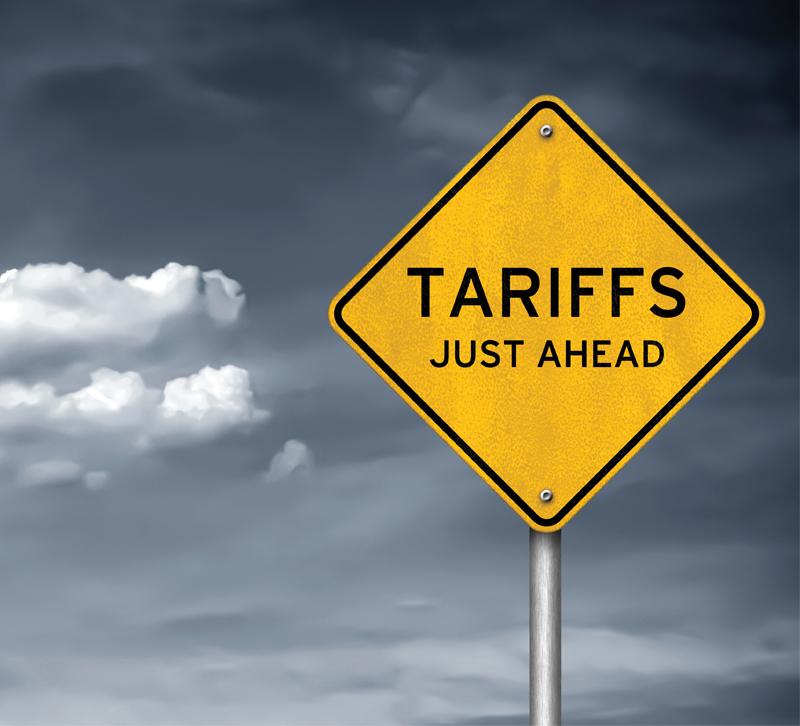
President Donald Trump has levied sweeping new tariffs on nearly every American trading partner around the globe, with some of the highest percentages on countries with which the home furnishings industry does the most business. Companies that manufacture and sell home accents have been struggling since yesterday’s late afternoon announcement to comprehend and assess what it means for their business.
“I was simply shocked that the tariffs reached all of the manufacturing hubs — locations that affect our industry,” said Ken Ludwig, an interior designer who also operates a retail store, Kenneth Ludwig Chicago. “It will now affect all our imported lines from furniture to lighting to accessories. But additionally, it will affect parts on our American-made upholstery and case good segments. This is only going to hurt all of us in the furniture and home furnishings. It will hurt retail immediately and then spill over into the to-the-trade arena, as well as online sales.”
Manufacturers, meanwhile, are trying to make decisions and strategize on the fly, believing the administration’s policies are still subject to change.
“It’s very disruptive. It’s terrible,” said Brad Kleinberg, president of lighting manufacturer Crystorama, who said that until now, his business has been strong. “I don’t know what tomorrow is going to bring. It’s very hard to continue expansion, very hard to do a business plan right now.”
“We are going to give it a few weeks and hope they will be negotiated down,” said Kranthi Yarlagadda, president of KAS Rugs.
Reza Momeni, president of Momeni Rugs said, “The known tariff will affect our company’s bottom line for this year as our imports from India, China and Turkey are ongoing for the rest of this year. We will make adjustment on product selections as tariff rates are more clear going forward.”
“My thoughts are to cautiously move forward,” said Melissa Walz, vice president of sales at HiEnd Accents. “Panic never helped any situation. In the next few weeks, the trade negotiations will continue, so no one really knows today what the true tariffs will actually settle to be and how they will impact the way we do business. Until we have a full picture and understand the climate in the marketplace, we will continue to focus on development, design and continue aiding our retailers as they navigate their businesses with our products.”
Jason Phillips, CEO of Phillips Collection, said he is actively monitoring the situation in real time. “While it’s still early to determine the full impact, we remain focused on agility and risk mitigation across our supply chain and pricing strategies,” he said. “We’ve already implemented contingency plans in recent weeks and are prepared to adjust as the situation evolves.”
“Right now, we are in a wait and see situation as we think things will settle around the world,” said Jamie Young, president and Gary Finder, CEO of Jamie Young Co. “We have the inventory, we are 95% in stock, so this is a great thing right now. While that inventory isn’t affected, prices will have to go up across the industry, which means we all need to be very curated and surgical on how we grow the product assortment.”
JJ Hjalmarson is the founder of First Sale Tariff, a consultancy and platform designed to guide importers through the complexities of international trade in 2025. In a recent op-ed piece for Home Accents Today, he shared suggestions for importers looking to reduce their Cost of Goods Sold (COGS) through strategic tariff management. His company preaches “agility and resilience,” Hjalmarson told Home Accents Today in an email message, but this latest round of tariffs announced on “Liberation Day” still came as a shock.
“Candidly, the outcome of the April 2nd announcement is worse than we could have imagined at FST,” he said. “The unseen costs of these tariffs and the years of work that have gone into our industry diversifying our supply chains out of China to places like Cambodia, Vietnam and the Philippines are incalculable. When you layer in the real added cost of 54% new tariffs out of China and other increases across the board, the impact on pricing and resulting sticker shock to consumers is unavoidable. There are still plenty of practices and policies importers can implement to help mitigate these costs, but the need to raise prices will be all but universal.”
Unavoidable price increases
Over the past month, after the first round of tariffs was imposed on imports from Mexico and Canada (those countries were left off of yesterday’s increases), many manufacturers began to notify customers of unavoidable price increases. Now, they must contend with even higher tariffs.
“Our stance on the tariffs is to absorb what we can and pass through the balance,” said Brian Berk, president of The Howard Elliott Company. The company emailed a letter to customers two weeks ago notifying them of price increases that would go into effect April 1. Those prices are posted on the company’s website. All pending in-stock orders that were shipped prior to April 1, 2025, were invoiced at existing prices, according to the letter. Orders that have products that are not in stock or that are not confirmed and released prior to April 1, 2025, will be subject to new prices, it said.
“We believe that the public is being misled in that the countries exporting these products are not paying these tariffs,” Berk told Home Accents Today. “The importers in the U.S. — i.e. Howard Elliott and their peers — are paying them. This results in higher costing inventory which must be passed along to our customers and ultimately the public. We have initiated price increases effective April 1st and we will monitor the situation closely and adjust pricing where necessary in the coming weeks.”
“I believe that most of the home décor category will become more expensive but in most of our categories, we simply cannot produce domestically due to insufficient work force and simple economics,” Berk added.
Crystorama’s Kleinberg agreed. “I can’t just switch companies or start manufacturing here. It will just result in higher prices and lower margins.”
“Pricing increases are coming in the next month and I’m trying to make sure I hit certain price points,” Kleinberg said. “I can’t unilaterally raise prices because certain items have to meet a certain threshold. It’s tough, a hard way to predict future success.”
He is considering adding surcharges to bills to cover the tariff increases. Those surcharges can be removed later, but he said he knows that “everyone hates surcharges” because they cannot be factored into IMAP pricing and make lighting showrooms less competitive with e-commerce companies.
“I want to support vendors. I want to give retailers a sweet spot in prices. I want us to remain healthy ourselves. It’s a great balancing act.”
Michael Rosilio, president of Meridian Furniture is hopeful that the tariffs will be trimmed back. “Sky-high tariffs like 70 percent for China or 40 percent for Vietnam are simply unrealistic. The reciprocal tariff of 10 percent that was anticipated could more easily have been absorbed, but those ‘shock and awe’ numbers reported on day one will not stick,” he said. “If they did, it would hurt the American consumer, which we know the administration does not want to do. All Meridian products that we sell are already in our warehouse and there are roughly 11,000 SKUs on hand right now, so there is a little bit of a runway for our customers. We will obviously be working with our manufacturing partners to create solutions that benefit our dealers and their customers as we are all in this together.”
Any price increases will be passed on to the consumer, according to Hossein Azimi, Bellini Modern Living CEO. “The timing of these tariffs is poor. Like everyone else in the industry, we are trying to understand what the actual tariffs are because of the confusing way this has been implemented and communicated,” he added. “However, we are a resilient industry and all of us have weathered turbulence in the past, and we will work with our dealers to help minimize the impact for them and their customers.”
Impact on vendor partners
Kleinberg also worries about his vendor partners in China, where he does most of his manufacturing (the company outsourced a small amount of production to the Philippines, he said, and looked into manufacturing in India, but the learning curve there has been big and it’s been hard to find a partner there who can do what he needs.)
“Our Chinese [partners] appreciate our business because they see a lot of business shifting away from China,” he said. Many of them are small family businesses, he said, and they don’t feel the Chinese government, which is more focused on the tech field than labor-intensive fields, will subsidize them in any way. “They feel squeezed and concerned,” he said.
“They’ve given us the lowest prices they can to stay in business, and I want them to be healthy,” he continued. “The only thing we can really do at this point is do the best to lower costs in any way I can – any processes I have that can be improved, and be as efficient as possible, and work at a closer margin to keep pricing [stable].”
Hjalmarson’s recommendation is to “Do the math, be transparent with your customers, and do your best to keep costs low.”
More changes could be on the horizon, he noted.
“”There is still a lot that could happen between now and the go-live date of April 9th for reciprocal tariffs. In an ideal world, all U.S. trading partners come to the table with concessions and tariffs reduce and U.S. imports abroad rise. The worst-case scenario is that the countries of the world band against the United States and say ‘do your worst’ or even raise their own tariffs. If that happens it is highly likely that we experience a period of stagflation as both prices and unemployment start to rise.” — Anne Flynn Wear contributed to this report
See also:
Trumps slams the door on the de minimis loophole for Chinese goods
Design industry responds to reciprocal tariffs, citing potential what-ifs and challenges
Credit: homeaccentstoday.com









